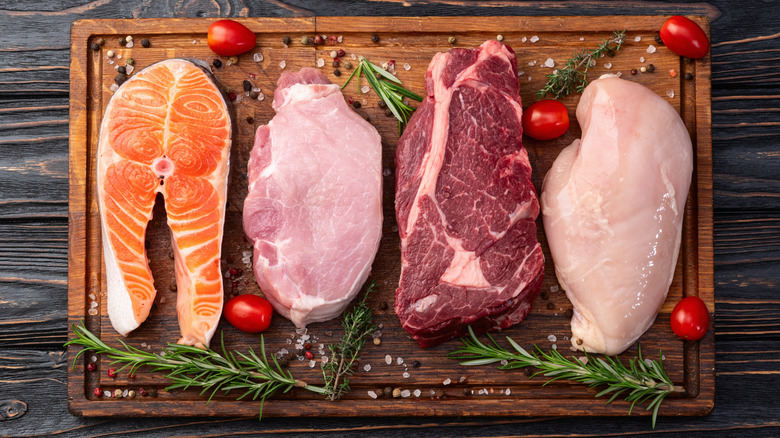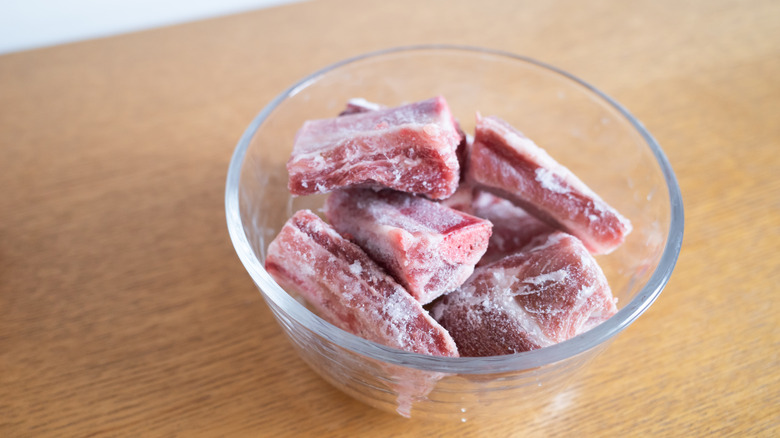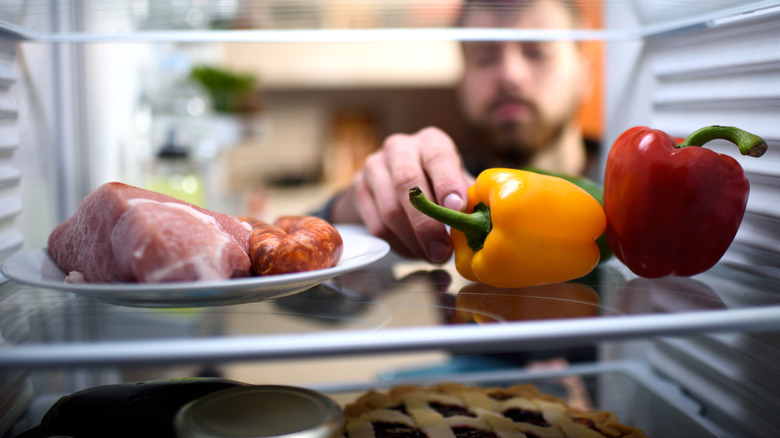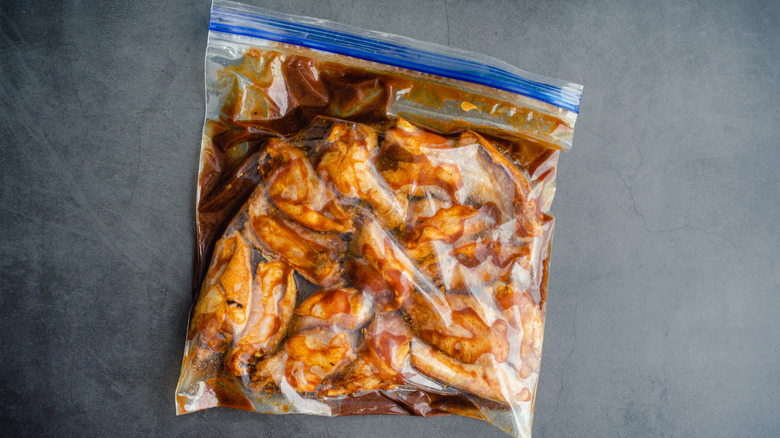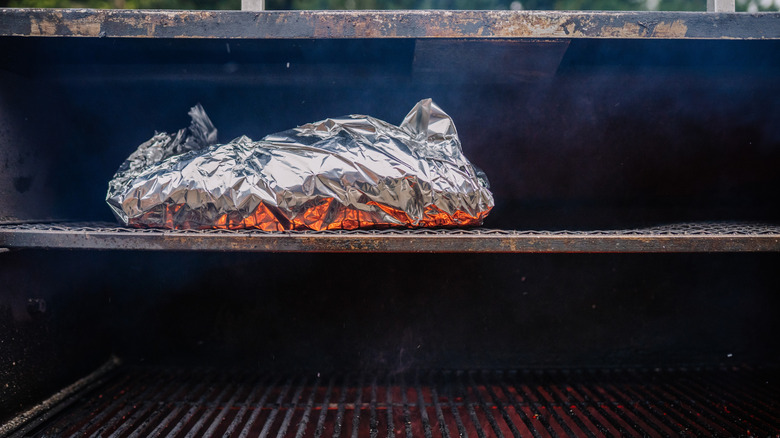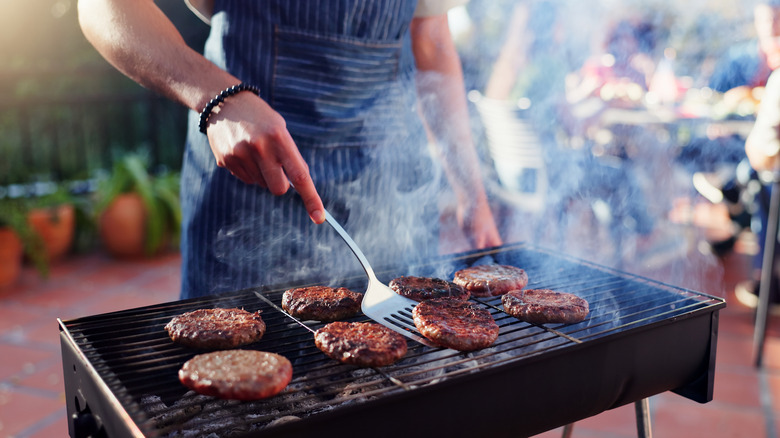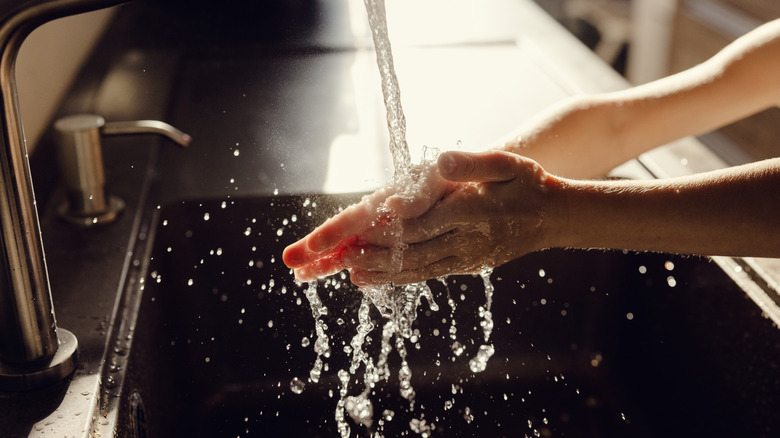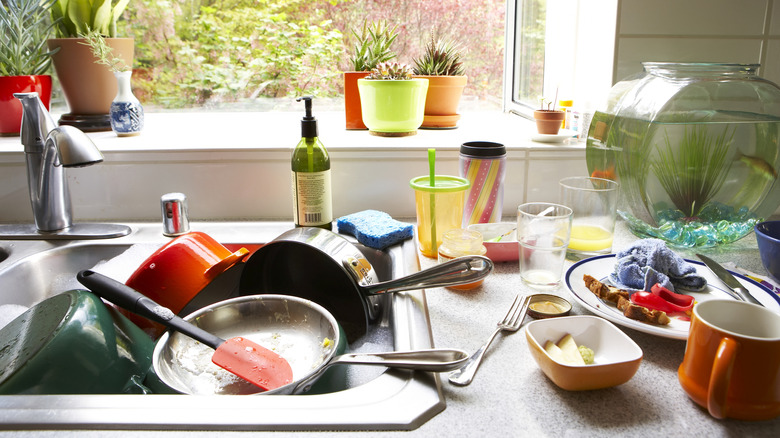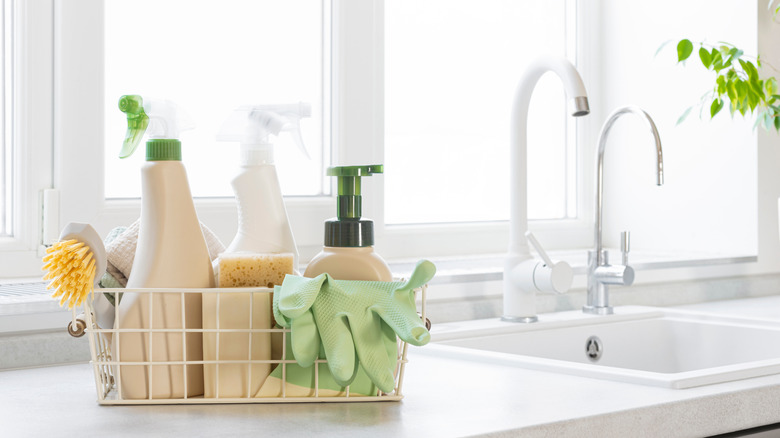10 Meat Food Safety Mistakes To Avoid
For the better part of the last decade, I have worked in food service operations, ranging from college dining halls to historic seafood restaurants, and have picked up a ton of food safety knowledge on the job. I even completed a food safety/person in charge certification course recently that broke down the science and specifics behind all kinds of food safety topics. Perhaps surprisingly (or perhaps not), there are tons of little mistakes people make all the time when cooking with raw meat. While you can sometimes squeak by making a couple of these food prep blunders, minimizing these mistakes will keep your chances of foodborne illness low.
Needless to say, learning all these tips has certainly changed the way I move in the kitchen and has made me quite the nag when I cook with friends. From how we thaw meat to how we clean up after dinner, there are several ways we can reduce the risk of food poisoning and other food-related illness (and improve the quality of the meat we cook!). Read on to find out if you're making any of these food safety mistakes, why it matters, and what to do instead.
Picking meat out at the grocery store first
While you're grocery shopping, it's easy to get distracted. Between browsing the aisles, adding forgotten items to your list, or even making extra stops after you check out because you just remembered something else you need to do ... it can be tough to stay concentrated. And during all this time, the chicken in your cart — or the car — is getting warmer and warmer. Meat can only be unrefrigerated for up to two hours and remain safe to cook and consume. To those of you living in hot climates, keep in mind this time drops to one hour if it is more than 90 degrees Fahrenheit. So, those extra stops might have that clock ticking too close to the "danger zone" (40 to 140 degrees Fahrenheit) for comfort.
Whether you plan on taking a big-time shopping trip to stock up on absolutely everything or just want to leave yourself time for any extra unplanned stops after shopping for the essentials on your grocery list, it's a good rule of thumb to always choose your meat products last. This will limit the amount of time raw meats are left unrefrigerated and decrease the chances that your products will develop any harmful bacteria in the "danger zone."
Washing raw meat
Though some home cooks are adamant about washing their meat before preparing, the U.S. Department of Agriculture (USDA) has determined that this step is not necessary or beneficial, and actually increases the risk of cross contamination and the spreading of bacteria that can cause foodborne illnesses. This is because, as you're rinsing the meat in the sink, countless water droplets containing harmful microbes from the meat are splashing all around — onto the counters, sink, handles, etc. This creates a much larger area to clean and sanitize properly if you want to eliminate the risk of contamination.
Cooking meats to their specific safe internal temperature kills these bacteria, so adding extra steps to the preparation process increases the risk of transporting these microbes around the kitchen. Keep in mind that these required temperatures vary for different kinds of meat and poultry, so be sure to keep a meat thermometer on hand to confirm the internal temperature exceeds that threshold.
Generally, the USDA recommends beef and pork be cooked to an internal temperature of 145 degrees Fahrenheit, with ground beef and pork needing to reach 160 degrees Fahrenheit. Chicken and other poultry, whether ground or not, need to be cooked to an internal temperature of 165 degrees Fahrenheit.
Thawing at room temperature
While it may be routine to thaw chicken breasts or pork chops on the counter, these moves pose safety risks. Raw meat and poultry should always be kept under 40 degrees Fahrenheit, as warmer temperatures allow harmful bacteria to grow and spread. When the outer layers of the meat begin to thaw on the counter or under hot water, they may approach and exceed this 40 degree threshold while the center remains frozen, leaving your meat unready to cook on the inside and risky on the outside. The "danger zone" of 40 to 140 degrees Fahrenheit should always be avoided in order to prevent the rapid bacterial growth that can occur between these temperatures.
To play it safe, you should thaw your meat in the refrigerator. Admittedly, this does take much longer, and you should allocate at least a day for smaller packages to thaw; this time grows longer with larger products like frozen turkeys and hams (generally 24 hours/five pounds). You can also thaw meat in the microwave or in cold tap water. Microwaving to thaw can be a good option in a pinch, but do be sure to use the meat immediately, as the microwave may cook some of the meat, putting it at risk of being in the "danger zone." Thawing in cold tap water requires more attention to be sure the temperature stays in a safe zone without being too cold to thaw, but is still quicker than thawing in the refrigerator.
Storing meat on top or middle shelves
When the fridge is jam-packed with groceries, it can be tempting to just put items wherever they fit. But please, fight the urge! The safest place in the refrigerator for raw meat, poultry, and fish is at the very bottom, wrapped and separated and always stored below ready-to-eat and prepared foods. Not only is the bottom of the fridge the coldest part, but if the container was to tear or become compromised, fluids from the uncooked meats could drip onto fresh foods and cause foodborne illness.
Even if the package seems to be in good condition, grocery shelves are not guaranteed to remain completely clean, and it is very common for contamination to occur between products during transport. Just think, it only takes one package of chicken to get a small tear during the shipping process for several of the packages around it to become contaminated. All of these then go onto the same shelves, and could be spreading bacteria to items all around. To be sure this contamination doesn't accidentally spread to the rest of your fridge and kitchen, storing all meat in the same place, at the bottom of the fridge, is your best bet. And don't be afraid to rewrap them if you'd like, too.
Marinating meat on the counter
While this method may be acceptable for a quick marinade during preparation of other parts of the meal, regular food safety rules always apply when handling raw meat, and marinades longer than two hours should always occur in the fridge. The same goes for brines (mixtures of water, salt, and other ingredients often used to add flavor and improve texture of poultry products), and for larger items like turkeys or chickens, you'll definitely want to clear some space in the fridge — step aside, cooler — as items do need to be fully refrigerated during brining.
Though they aren't absolutely necessary, marinades and brines can add excellent flavor and texture to a variety of meat products and can really take your dish to the next level. Whether you're grilling juicy steaks, baking crispy breaded chicken breasts, or sautéing some flaky fish, marinades and brines can add a lovely addition to your meal.
Smoking frozen meat
Smoking is a fantastic way to cook tender, deeply flavored meat, fish, and poultry. This method is particularly effective for preparing large cuts of meat like roasts and whole birds — things we often buy or purchase frozen. No smoker, no problem! You can even turn your grill into a smoker to join in on all the slow-cooked, delicious fun.
However, keep in mind: It's important to completely thaw frozen items before smoking them. This is for a few reasons. Primarily, this step is key to preventing foodborne illness. As smoking is a low-temperature, prolonged preparation method, meats (especially the larger cuts) will take a long time to thaw in the smoker, which increases the likeliness that meat will enter the infamous danger zone (40 to 140 degrees Fahrenheit). Thawed meats will also have a more consistent flavor and texture than those that go into the smoker frozen. This is because, although heat does still take time to penetrate into the middle of the meat, this time is diminished when the meat is all the same, slightly warmer, temperature. Imagine smoking your delicious turkey all day just to pull it out and realize the center is still underdone and the dinner bell is ringing. Let's avoid the trouble!
Skipping the meat thermometer
Seasoned home cooks may feel the urge to skip the meat thermometer, relying on appearance, firmness, or a trusty time-based method that has never failed. While this may fly most of the time, the only way to be 100% certain that your food is thoroughly cooked is to check the temperature with a meat thermometer. And don't worry, you don't need anything fancy; you just need to know how to use your meat thermometer the right way.
A digital thermometer is the fastest, most specific type to get a quick read without having to sit around too long, but a calibrated analog thermometer will also do the job. The drawbacks of analog thermometers are small, but notable. They do take a bit longer to get a read, and they are less specific than digital thermometers, which can read to the tenths of a degree. If your meat is quite a few degrees above the minimum temp, no need to fret, but if it's right on the cusp, better to play it safe and give it a few extra moments on the grill, in the pan, or in the oven rather than rounding up and hoping — potentially exposing yourself (and your guests/family) to harmful bacteria in the process.
Neglecting hand washing
As repetitive as it may feel, it is absolutely essential to wash your hands every time you touch any raw meat, its packaging, or any surface or utensil that has come in contact with it. Imagine: You're prepping your pan-seared steak with a bit of cracked black pepper, so you pick up the pepper grinder without washing your hands after pulling your steak out of the package. Tomorrow, when you go to add some fresh black pepper to your salad dressing and reach for the grinder before chopping up some fresh herbs, you risk exposing yourself and anyone you're feeding to the bacteria that were present in last night's steak.
To be safe, always take a pause after handling raw meat and give those hands a good wash (lathered with soap and water and washed for at least 20 seconds) to avoid spreading bacteria to pesky places. It's much more time consuming to wipe down all your spices to sanitize them than it is to wash your hands more frequently.
Leaving dishes around
Once the meal's been made, dinner's been eaten, and you're just feeling like kicking back and letting the drowsiness hit you, remember to prioritize a prompt cleanup. Just because you know which knives, bowls, cutting boards, and other dishes have been contaminated after coming into contact with raw meat doesn't mean everyone in your home does. Even just moving a dish to the side can risk spreading foodborne illness if that dish was contaminated by raw meat.
It's easy to see how quickly bacteria can spread around even tidy kitchens, and the sink is a major culprit. Besides accidentally touching something contaminated, when substances dry onto dishes, they become drastically more difficult to remove. This makes the scrubbing process more laborious, time-consuming, and forces you to be more meticulous while hand washing your best knives, wooden cutting boards, and any other dishes you cannot put in the dishwasher. It's much easier to get it done right after the meal, so then you can really relax later. If you've been a lifelong rinser, don't panic. You can sanitize your sink (and as much of your kitchen as your heart desires) with a medicine cabinet staple — hydrogen peroxide is an easy way to disinfect your sink!
Waiting to clean counters
It's so easy to want to save brushing up the crumbs and cleaning your gunky stovetop for tomorrow after you've made a big, elaborate meal (or even a simple one). But washing and sanitizing counters promptly after you've finished cooking and eating is crucial to ensuring that foodborne-illness-causing bacteria aren't being spread around your home. Plus, all kinds of other stuff can be left on the counter too. Flour, oil splatter, veggie scraps, and other little crumbs can cause trouble down the line, like pests, unpleasant smells, and counters you now have to scrub with elbow grease, when last night it could have been an easy wipe down.
When it comes to countertops, a good clean and sanitize after (and honestly, before) they come in contact with raw meat products is essential to eliminate the spreading of bacteria from the immediate area to all over the kitchen. This also prevents ready-to-eat foods from acquiring these bacteria. You wouldn't want to risk setting your cutting board on a contaminated surface for one part of the meal prep and forget to wash both sides, unknowingly cross-contaminating your next meal.
